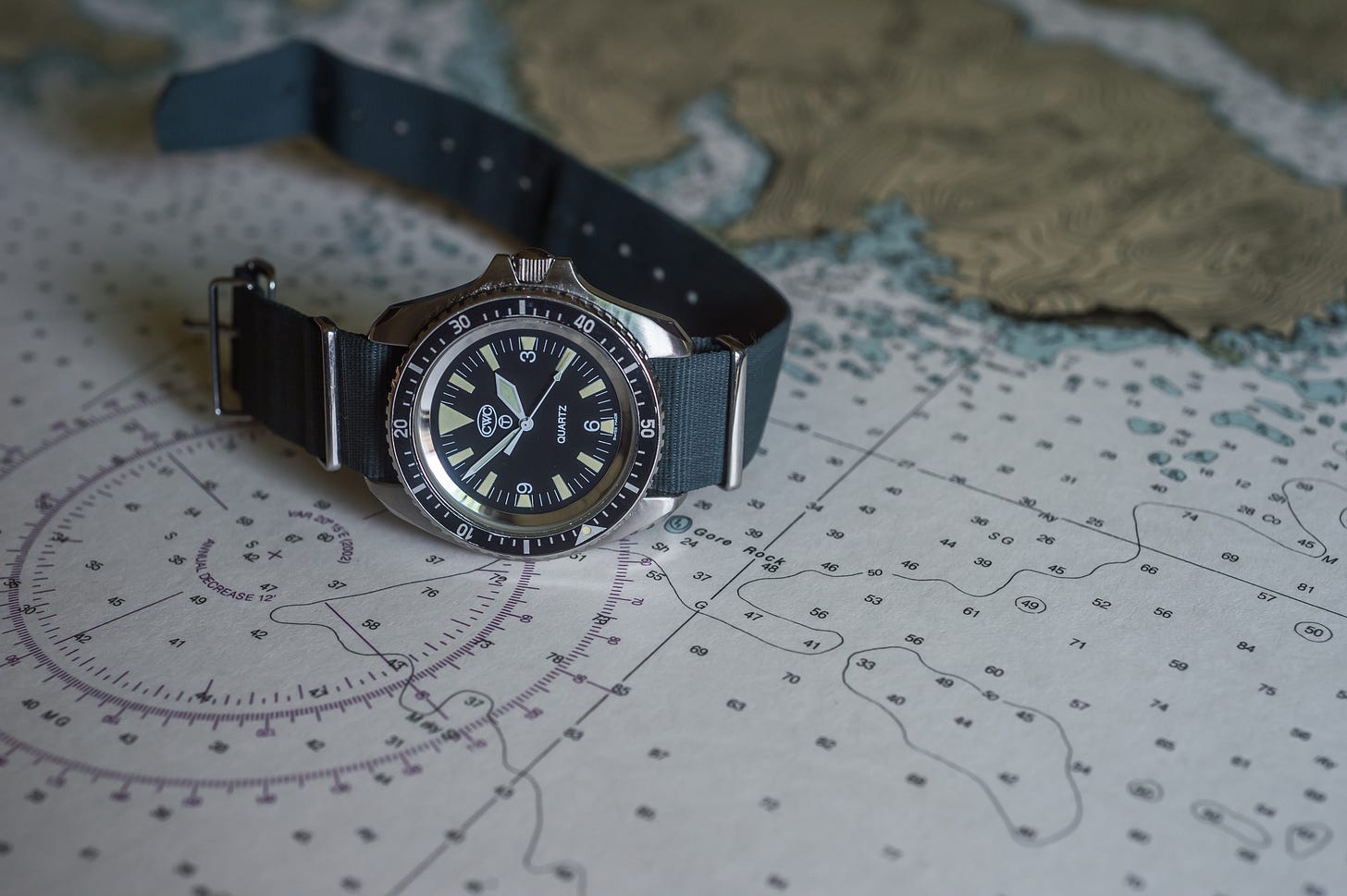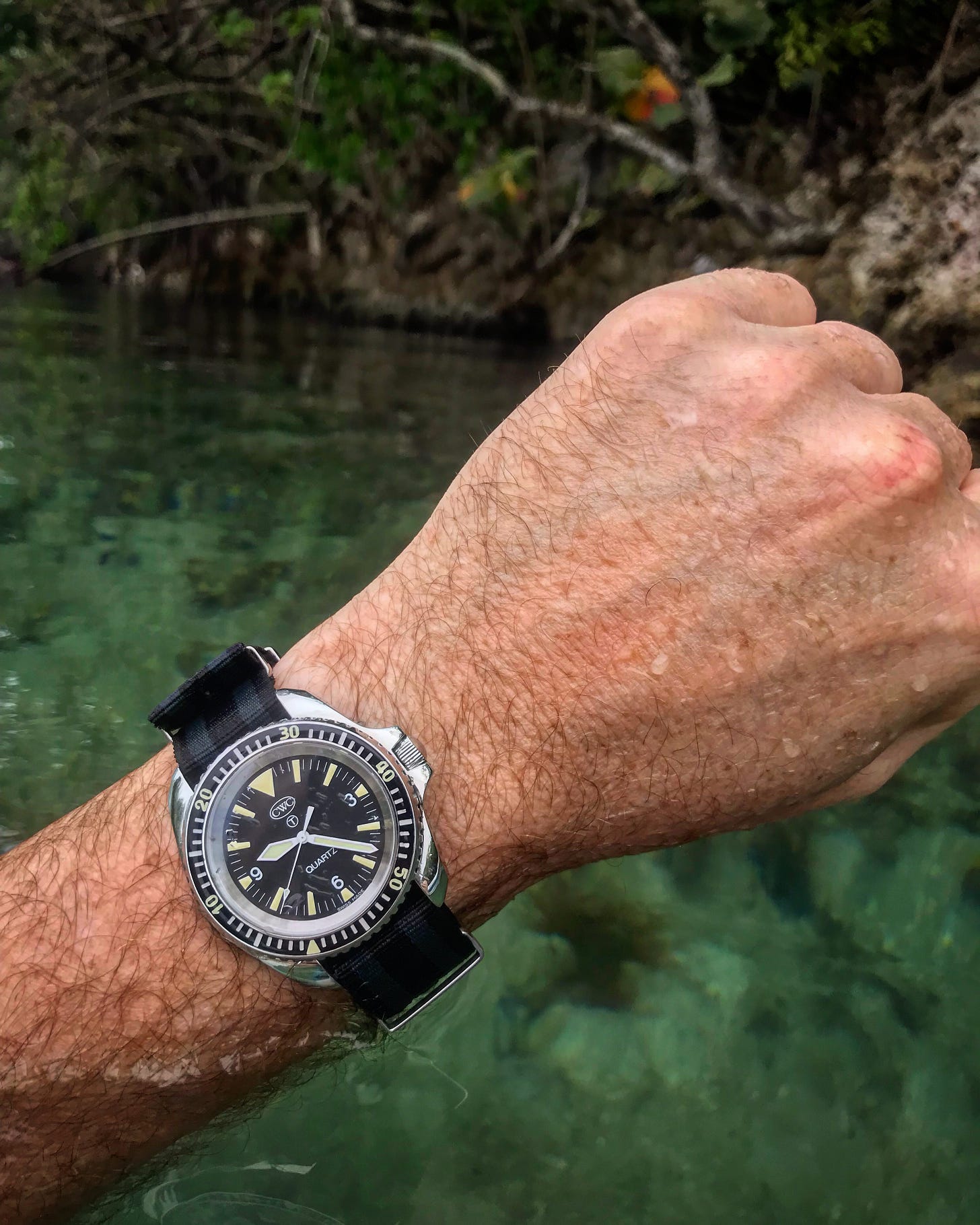Quartz proud
Embrace the battery
I am a child of the Quartz Age. Born in the year following the introduction of the first quartz wristwatch, the first two decades of my life paralleled the ascendency of battery powered watches—first analog, then digital, then even analog-digital— and the decline of the Swiss mechanical watch. It is odd then, that my first real watch, bought with my own hard earned money, was an automatic winding mechanical Seiko diver. OK, I think I had some sort of quartz Armitron in early high school days, but the fact that I can’t remember anything about it says a lot. I saved $85 for that Pepsi-bezeled Seiko and remember being utterly fascinated by its sweeping smooth seconds hand and alternating Arabic day display (why an Arabic variant was sold in a suburban Milwaukee mall store remains a mystery).
There seems to be an arc of progress with most people. We first embrace, then shun, the objects, culture and fashions of our own formative years, then later come to appreciate them again. I think of ‘70s fashion with its shades of brown, safari style and wide legs, disco music (have you watched the new Bee Gees documentary?), or of that eras cars, the absolute nadir of American car manufacturing. It was the same with watches. Even by the 1980s, I was already rejecting the prevalent digital Pulsars, Seikos, and Casios, favoring a rather outmoded analog mechanical for my own wrist. There were some years after that when I wore Suunto digitals, but more for their outdoor credibility than any appreciation of these “wrist top computers” as they called them, as a proper watch. Once I rediscovered watches, like many of us, mechanical was the only way to go. Batteries were for the unwashed masses. To be a true watch aficionado, you had to own something with a coiled spring and geartrain. If it was Swiss and made “in-house," all the better.
Somewhere along the way, a decade into my watch appreciation, I rediscovered quartz watches. At first, it was the odd Marathon or Victorinox, kept in the collection as the proverbial “beater," that watch you call on for rough duty, with all the well known descriptives: “grab and go” and “bombproof.” But it wasn’t really appreciation in the true sense. It was a grudging acknowledgment that quartz was OK, but only for the crudest purposes, the less glamorous the better. If you want to live in my stable, you had better earn it! Bash it on an engine block, split wood with it on, cut the grass. The watches rarely stuck. I’d sell them, give them away as gifts or simply destroy them.
Then, a funny thing happened. My own “tough guy” watch rhetoric caught up with me. In my years of reviewing luxury mechanical dive watches, those supposedly indestructible variants of the wristwatch, the dawning reality that the reason most divers don’t wear high end watches anymore, and world militaries long ago abandoned their Seamasters and Submariners for CWCs and G-Shocks, was because they needed the most durable and affordable options and ones with the most functionality. Now, I wasn’t so naive as to not know this, but my own platitudes of “shockproof/waterproof/anti-magnetic/easy to grip with gloves” were really just justifications for wanting to wear something nostalgic and, let’s face it, cool, while out doing cool stuff. And to be clear, there’s nothing wrong with that. But it was when I came to terms with this that I finally became able to truly appreciate quartz watches not simply as disposable beaters but as nothing less than state of the art, a culmination of years of evolution. It also helped me place my “luxury” watches into their proper place.
Another epiphany in my quartz appreciation journey came courtesy of, fittingly but also perhaps ironically, Seiko. Five years ago, I was on a press trip with some other journalists in Japan, hosted by Seiko. We visited three of their manufacturing facilities where we saw everything from Astron GPS watches to enamel dial Credors being designed, assembled, and polished. In Morioka, we donned slippers and hairnets and walked reverently past watchmakers assembling Grand Seiko mechanical movements at their custom wooden benches. This was the highest level of Japanese watchmaking. When we exited the quiet room, our guide ushered us past another space, entirely sealed off behind large glass windows, and directly across the hall from the Grand Seiko room. Inside was a fully automated assembly line churning out quartz movements by the thousands per hour. Our guide was no less proud to show us this movement production as he was the hand assembled GS workshop. Later we learned about Seiko’s in-house cultivation of quartz crystals and the care taken in their high end 9F movements that feature anti-backlash gearing and tolerances that render the watches accurate to within seconds per year. I remember leaving Japan wanting a Grand Seiko 9F quartz watch. Ironic, given where watch appreciation all began for me, with an automatic Seiko diver.
I still don’t own a Grand Seiko quartz watch, namely due to my own discomfort with dress watches. And while I do think quartz would make a lot of sense for me in a dress watch for occasional wear (“grab and go” for a different reason), seeing Seiko’s own pride in their quartz watch production at both the highest and lowest levels made me further reconsider this red headed stepchild of horology.
Looking at my own collection, it is no surprise that the quartz watches I own now are all dive watches. A few years ago, I bought a 1995 CWC Royal Navy dive watch that had been issued, I was told on good authority, to a member of the Special Boat Service. That watch has accompanied me on a few adventures, most notably a dive to the deep wreck of HMS Hermes, the world’s first aircraft carrier. The watch, to me, represents the best of both worlds. It retains the form factor of a previous generation of standard issue military diver but was of a generation when the Ministry of Defence recognized that quartz was the way forward. I also own a newer CWC RN diver, their 1983 re-issue, which is a revival of that very earliest quartz dive watch, with a poured resin luminous bezel. I wear both of these often, interchangeably. Before the Aquastar Deepstar arrived in July, I wore the 1983 reissue CWC for the majority of the first half of 2020.
It’s odd to consider any quartz watch “vintage” and that ’95 CWC is bordering on it, but the one in my collection that is truly old is my Citizen Aqualand from 1986. This watch has become a dive watch icon in its own right, and has always represented, to me, the last great analog dive watch development before dive computers came into popular use. The watch has a classic dial configuration and knurled, fully hashed bezel, but then the case has this oblong protrusion on its left flank, the telltale depth sensor that made its functionality unmatched when combined with the small digital readout at 12:00. The rubber strap, vented for wear over a wetsuit sleeve is marked with no-decompression limits for different depths, leaving no doubt that this watch was built for singular purpose and is anything but a “beach to boardroom” accessory.
The other quartz watch I own is a Seiko SNJ029, the so called “Safarnie” (‘Safari’ + ‘Arnie’ for its color-way and fame on Schwarzenegger’s wrist). Also an analog-digital diver, it has the added advantage of being solar charged, meaning the only real weakness of a quartz watch, a dead battery, is mitigated.
Now that I inventory my own quartz watches, I see a pattern emerging. All are either old, or reissues of older watches. I suppose this renders my earlier statements about quartz being “state of the art” a bit hollow since I seem to be after a certain nostalgic vibe even with my battery powered timepieces. Truly state of the art watches nowadays are not even quartz, but connected smartwatches but, while I own a few Garmins that I love, I don’t really even consider them watches, since I hardly use them to tell time and their screens only grace my wrist with activity specific data flashing across them.
Is appreciation of quartz watches akin to that of mechanical watches? In some respects, yes, in others, no. To me, the appeal of a watch is largely an aesthetic thing—I wear what I like to see on my wrist. Secondly, and again I speak for myself, the aesthetics are backed up by some sense of nostalgia or cultural or historical tie-in. What goes on inside the watch, movement-wise, is actually a criteria that falls further down the list, as does finishing or refinement. The beauty of watch appreciation is that everyone comes to watches from a different perspective and I entirely understand why a mass produced battery powered printed circuit doesn’t appeal to most watch connoisseurs. But I come to watches from a background in appreciation for well designed and built outdoor gear and that naturally gives me a dive watch bent, and perhaps the next progression is to quartz ones for their ruggedness, and “set it and forget it” simplicity.
I won’t lie, I get a small thrill when, after a few weeks of wearing a few mechanicals that I have to wind and set, I pick up my old CWC and it’s dead on accurate. I strap on the NATO and head out the door. There is a well known hypothetical that asks, “If you had to wear one watch to a sketchy place to have some sort of adventure, which one would it be?” For many, it’s a Seiko dive watch, often mechanical. Not too precious, unobtrusive, durable, waterproof. That’s a fine choice and would be high on my list too. But for me, I think I would take one of my quartz divers. While a dead battery in the field might spell the end for a quartz ticker, it’s more easily mitigated than a random drop that can spell doom for a fragile hairspring, leaving you to carry around a broken watch until you can find a watchmaker.
All this having been said, my appreciation for mechanical watches remains strong and I’ll continue to collect and wear them. The miracle of a precision instrument made up of gears and springs living on my wrist through thick and thin is still pure magic to me. But there’s growing room for quartz watches in my collection and I’ll continue to proudly sing their praises to anyone that will listen (or, in this case, read). As for my appreciation for bell bottoms or mid-‘70s land yachts, I haven’t gotten there quite yet.





Jason,
Another great piece! I think anyone who says they don’t have a quartz watch or two or many in their collection are missing out on
good, perhaps superior, watches.
I did have a bad experience of having a quartz watch battery die when it was most needed - in Afghanistan no less! Shame on me - I should have followed the rule of two is one and one is none. My new solar powered “Arnie” solves all of that. Of course, my days going into Afghanistan are over.
Cheers mate!
Great piece and a lovely way of thinking of quartz as part of your story.